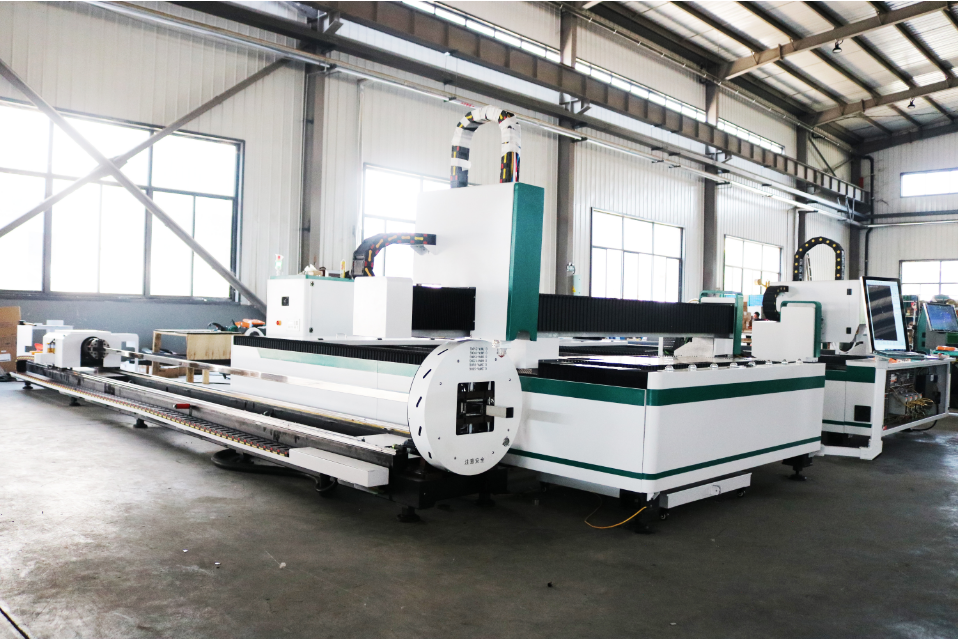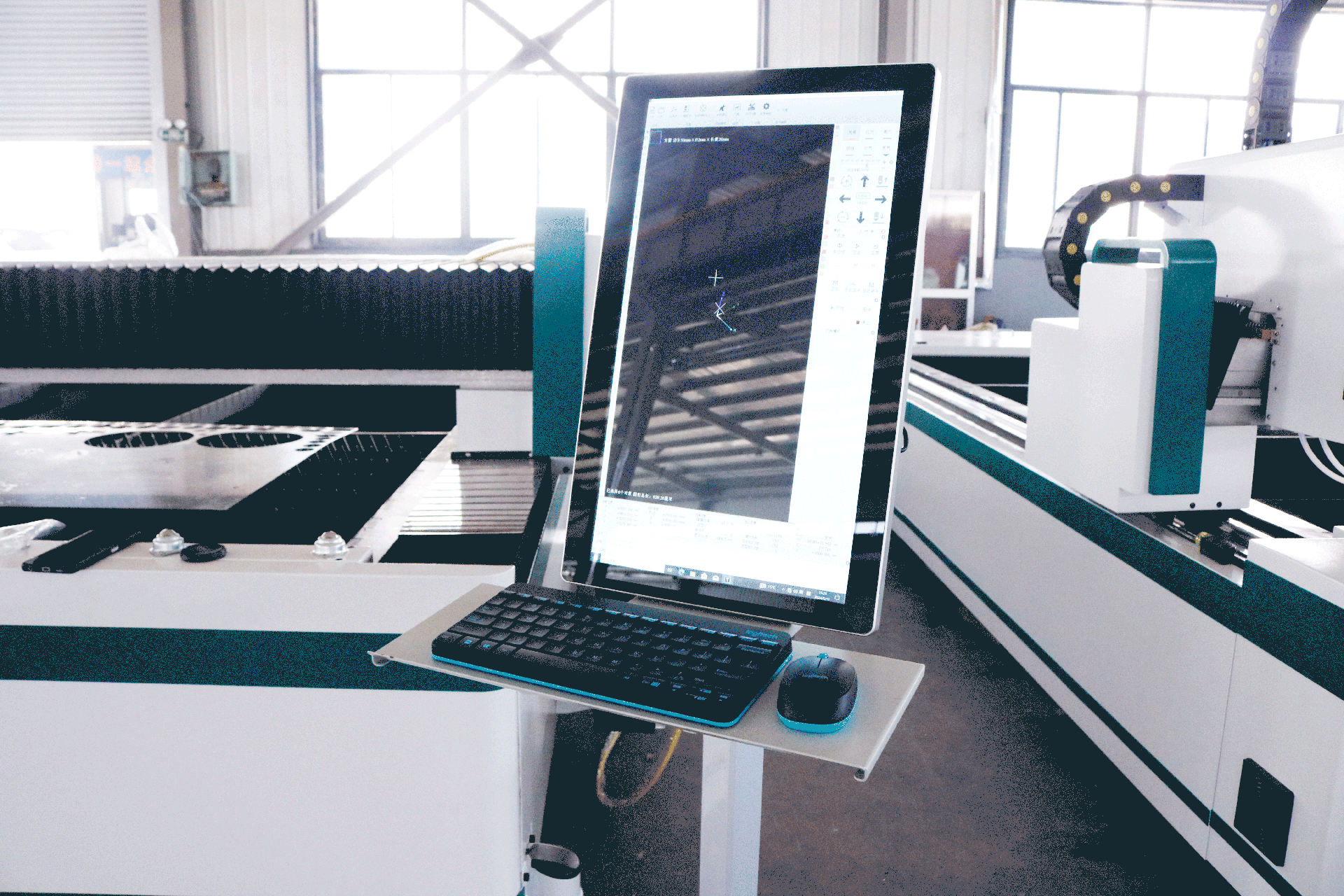Laser cutting technology must be familiar to everyone. Laser cutting technology is a processing method that uses a high-energy-density laser beam to accurately cut materials. It is widely used in the processing of metal and non-metal materials. The most common laser cutting equipment is laser cutting machines.
Laser cutting technology must be familiar to everyone. Laser cutting technology is a processing method that uses a high-energy-density laser beam to accurately cut materials. It is widely used in the processing of metal and non-metal materials. The most common laser cutting equipment is laser cutting machines.
Laser cutting machines use the cutting principle of lasers. The core of laser cutting is the laser beam generated by a high-power laser. Through a reflector and lens system, especially a focusing lens, the beam is focused into a very small spot, usually with a diameter of only tens of microns to hundreds of microns, thereby forming a very high energy density on the surface of the processed material.
Under the irradiation of high-energy-density lasers, the surface of the material quickly heats up to thousands to tens of thousands of degrees Celsius, causing the material to melt, vaporize or burn instantly. For metal materials, there may also be an oxidation reaction.
In the laser cutting process, high-pressure auxiliary gases (such as oxygen, nitrogen, argon or compressed air, etc.) are often used in combination. On the one hand, they help blow away the molten or vaporized materials, and on the other hand, they protect the cutting area, reduce the heat-affected zone, and improve the cutting quality and speed.

The main process parameters of laser cutting are cutting laser power, incision width, cutting speed and gas flow rate. Other factors, such as laser beam quality, lens focal length, defocus and nozzle, also have a great influence on laser cutting.
(1) Laser power
For material properties, if the surface reflectivity of the material is high, then when the laser irradiates the material surface, more energy will be reflected back instead of being absorbed by the material for cutting. Therefore, in order to ensure sufficient energy for cutting, it is necessary to increase the laser power. Similarly, if the thermal conductivity of the material is good, the heat generated by the laser irradiation will be quickly conducted inside the material, making it difficult for the temperature of the cutting area to rise to a level sufficient for cutting. At this time, it is also necessary to increase the laser power to improve cutting efficiency. In addition, cutting materials with high melting points also requires larger laser power and power density. This is because materials with high melting points require more energy to melt or vaporize them, thereby achieving the purpose of cutting.
(2) Cutting speed
Under certain power conditions, when the plate thickness increases, the laser beam needs to penetrate deeper material layers to complete cutting. Research shows that the relationship between cutting speed and cut surface roughness is not a simple linear relationship, but presents a U-shaped change trend. This means that for materials of different plate thicknesses and different cutting gas pressure conditions, there is an optimal cutting speed point. When cutting at this speed, the roughness value of the cut surface can reach the minimum, that is, the cut is the smoothest. Generally speaking, the faster the cutting speed, the greater the power required.
(3) Gas pressure (gas flow rate)
During the melting cutting process, the laser beam heats the material to the melting temperature. At this time, the sprayed gas plays the role of blowing away the liquid metal, thereby forming an incision. The gas pressure must be large enough to effectively remove the molten metal and ensure the continuity of the cutting and the clarity of the incision. The gas flow rate is also related to the nozzle form. Different nozzle forms have different effects on the distribution and flow characteristics of the gas, so the applicable gas flow rate will also be different. When selecting the nozzle and setting the gas flow rate, it is necessary to match and optimize according to the specific cutting requirements and material characteristics.
(4) Beam quality, lens focal length and defocus
The beam mode output by the laser is crucial to the cutting effect. The fundamental transverse mode (TEM00 mode) beam is considered to be the most ideal beam mode in laser cutting because of its small beam diameter and concentrated energy. Experimental studies have shown that the incision width is almost equal to the laser spot diameter during non-oxygen-assisted cutting. The spot size is proportional to the focal length of the focusing lens, that is, the longer the focal length, the larger the spot; the shorter the focal length, the smaller the spot. However, although a short focal length lens can obtain a smaller spot, its focal depth is also reduced accordingly. The smaller the focal depth, the more stringent the distance requirement from the workpiece surface to the lens. The defocus amount has a great influence on the cutting speed and cutting depth, and must remain unchanged during the cutting process. Generally, the defocus amount is selected as a negative value, that is, the focus position is placed at a certain point below the cutting plate surface.
(5) Nozzle
The nozzle is an important component that affects the quality and efficiency of laser cutting. Laser cutting generally uses a coaxial (airflow and optical axis concentric) nozzle, and the nozzle outlet diameter should be selected according to the plate thickness. In addition, the distance from the nozzle to the workpiece surface also has a great influence on the cutting quality. In order to ensure the stability of the cutting process, this distance must be kept constant.

Laser cutting of industrial materials
(1) Laser cutting of metal materials
Almost all metal materials have high reflectivity to infrared light at room temperature. For example, the absorption rate of 10.6μm carbon dioxide laser is only 0.5%~10%. However, when the power density exceeds , the focused beam is irradiated on the metal surface, the surface can begin to melt in microseconds. The absorption rate of most molten metals will rise sharply, generally up to 60%~80%. Therefore, carbon dioxide lasers have been successfully used in many metal cutting practices.
The maximum thickness of carbon steel plates that can be cut by modern laser cutting systems has exceeded 20mm. When cutting carbon steel plates using oxygen-assisted melting cutting method, the cutting seam can be controlled within a satisfactory width range, and the cutting seam for thin steel plates can be as narrow as about 0.1mm. Laser cutting is an effective processing method for stainless steel plates. It can control the heat-affected zone within a very small range, thereby maintaining its corrosion resistance. Most alloy structural steels and alloy tool steels can be cut with good edge quality by laser cutting.
Aluminum and aluminum alloys cannot be cut with oxygen-assisted melting. Instead, a melting cutting mechanism must be used. Laser cutting of aluminum requires a very high power density to overcome its high reflectivity to 10.6μm wavelength lasers. 1. The 06μm wavelength YAG laser beam can significantly improve the cutting quality and speed of aluminum laser cutting due to its high absorption rate.
Titanium and titanium alloys commonly used in the aircraft manufacturing industry have a violent chemical reaction when oxygen is used as an auxiliary gas, and the cutting speed is fast, but it is easy to form an oxide layer on the cutting edge and even cause overburning. It is safer to use inert gas as an auxiliary gas to ensure cutting quality.
Most nickel-based alloys can also be cut with oxygen-assisted melting. Copper and copper alloys have a high reflectivity and basically cannot be cut with a 10.6μm carbon dioxide laser.
(2) Laser cutting of non-metallic materials
The 10.6μm carbon dioxide laser beam is easily absorbed by non-metallic materials. Its low reflectivity and evaporation temperature allow almost all of the absorbed light energy to be transmitted into the material, and instantly cause vaporization to form holes, entering a virtuous cycle of the cutting process. Plastics, rubber, wood, paper products, leather, natural fabrics and other organic materials can be cut with lasers. However, the thickness of wood should be limited to 75mm for wood boards and about 25mm for laminates and wood chipboards. Among inorganic materials, quartz and ceramics can be cut with lasers, and the latter should be cut with controlled fracture and high power should not be used. Glass and stone are generally not suitable for laser cutting.
Other materials that are difficult to process by conventional methods, such as composite materials and cemented carbide, can be cut with lasers, but reasonable cutting mechanisms and process parameters must be selected through experiments.
In the actual application of laser cutting technology, improving cutting efficiency, improving cutting quality and reducing cutting costs are one of the things we often need to consider.
Improving laser cutting technology to improve production efficiency, cutting quality and reduce costs can be started from the following aspects:
1.With the advancement of laser technology, the use of higher power lasers (such as 10,000 watts) can significantly increase cutting speed, while reducing heat-affected zones and material deformation, making cutting more efficient and better quality, especially for cutting thicker materials.
2. Reasonably adjust the laser power, cutting speed, auxiliary gas type and pressure, nozzle and material distance and other parameters, and make fine settings according to the specific material and cutting requirements. Find the optimal parameter combination through multiple tests to improve cutting efficiency and quality.
3. Through the automatic focusing system, automatically adjust the laser focus position according to the material thickness and type to ensure cutting accuracy.
4. Reduce non-cutting time and improve overall operation efficiency by quickly moving the cutting head to the next cutting starting point.
5. Automatically detect the edge and tilt angle of the material, automatically adjust the cutting path, reduce material waste and pretreatment time.
6. Use CNC software for simulated cutting, plan the simplest cutting path, reduce empty stroke, and improve material utilization and cutting speed.
7. Regularly maintain and service the laser cutting machine, such as replacing wearing parts, cleaning optical components, calibrating equipment, etc., to ensure long-term stable operation of the equipment and maintain the best cutting performance.
8. Keep the working environment of the laser cutting machine clean, suitable temperature, and moderate humidity to avoid the influence of dust and excessive humidity on the equipment and cutting effect.
9. Use more advanced CNC control systems and software to improve control accuracy and response speed, and support more complex cutting tasks.
10. Continue to pay attention to new developments in laser technology, such as more efficient laser sources, more advanced optical systems, intelligent software algorithms, etc., to continuously improve cutting capabilities.



